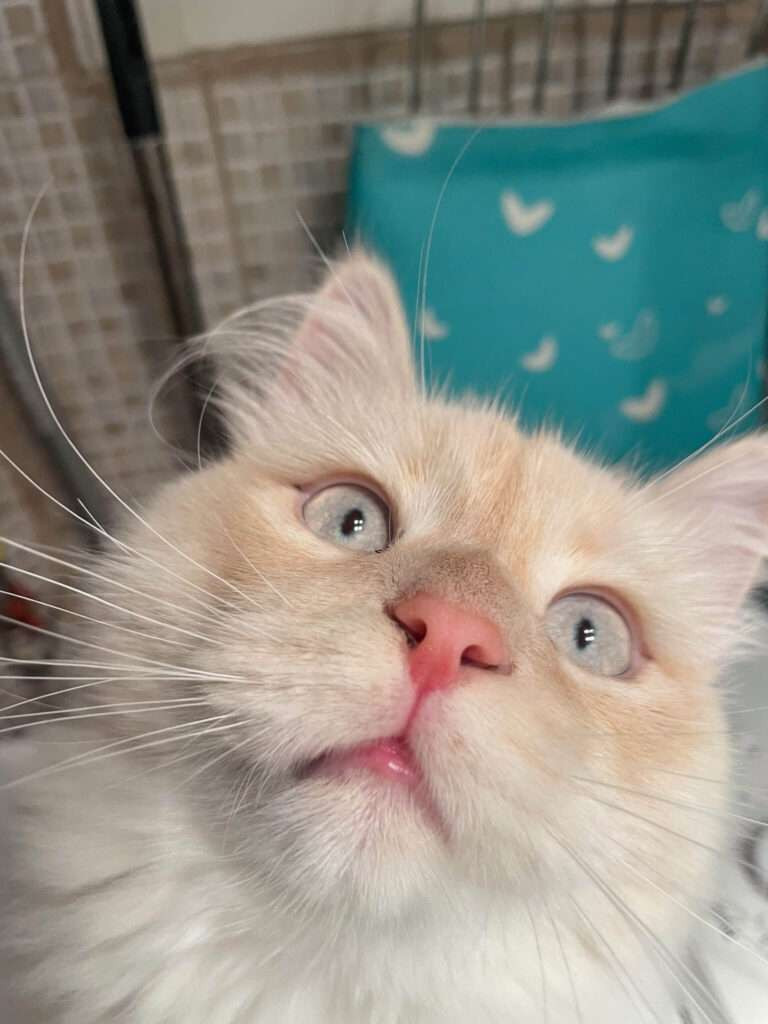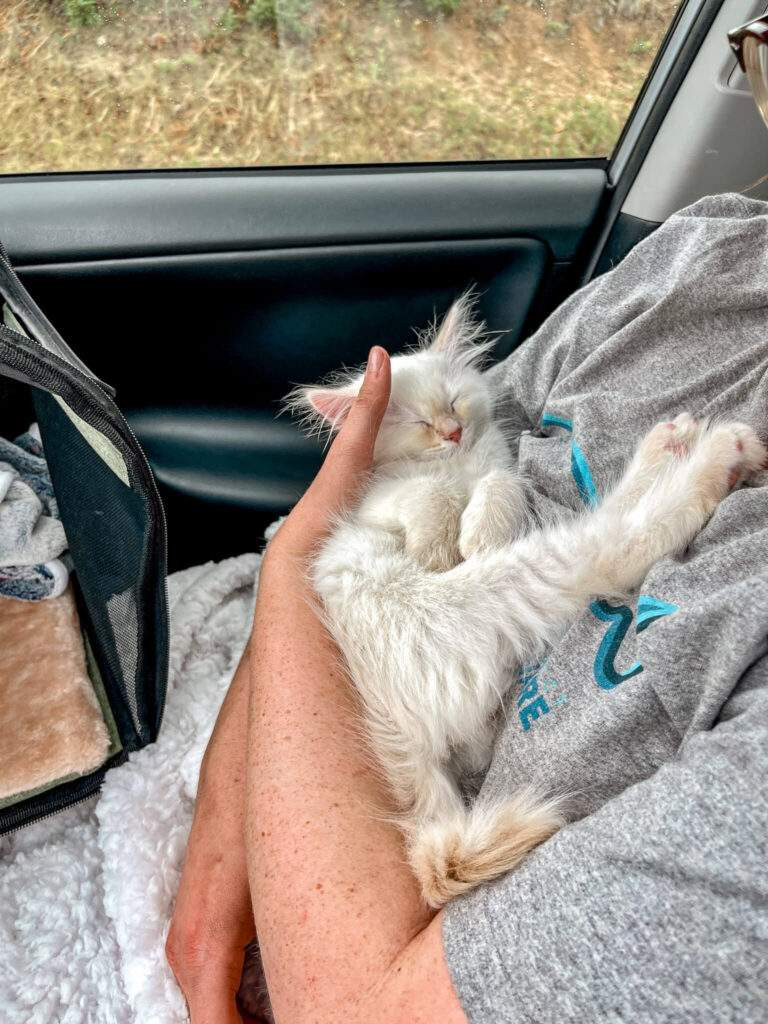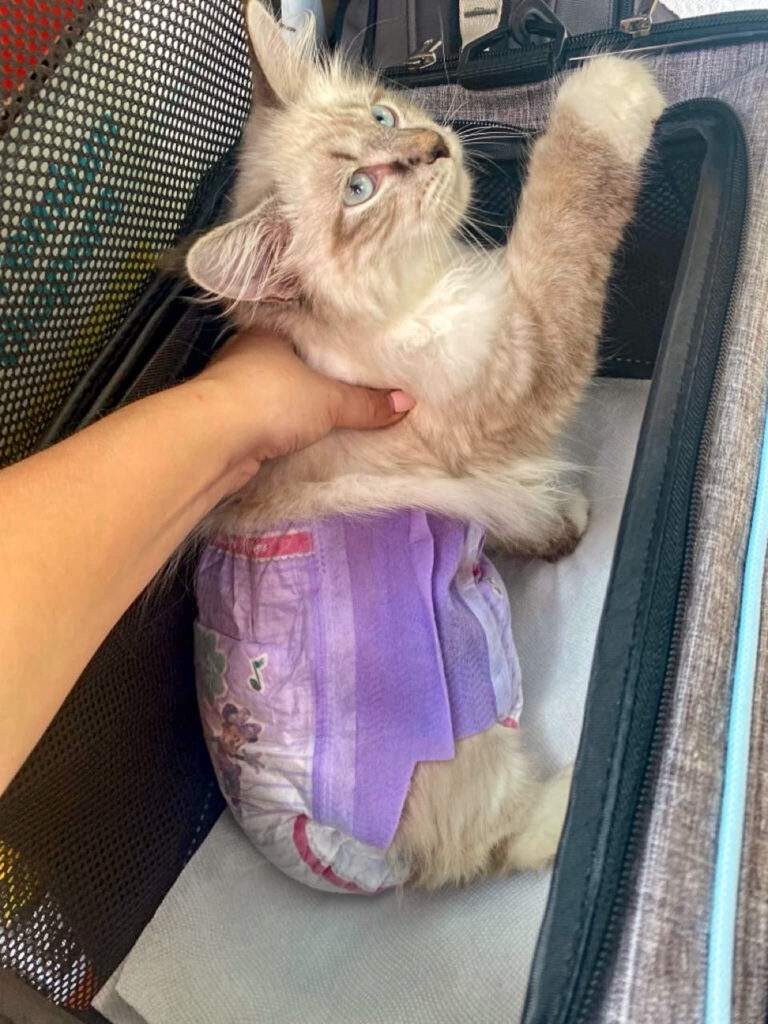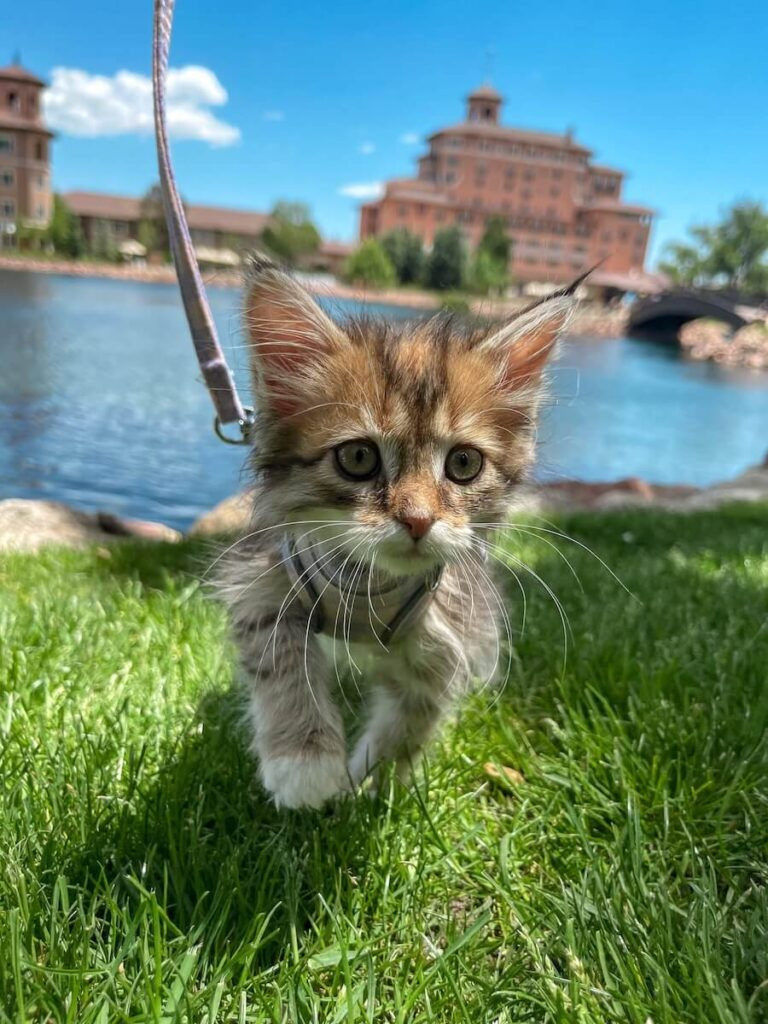Telling people you plan to fly internationally with your cat often elicits reactions ranging from amusement to outright disbelief. “You’re crazy!” is a common sentiment, and honestly, looking back, there’s a kernel of truth to that. It’s undoubtedly an adventure, but for many cat owners, the thought of leaving their furry companion behind during a big move or extended trip is simply unbearable.
If you’re considering taking to the skies with your feline friend, you’re likely asking yourself, ” Can I Fly With A Cat?” The answer is a resounding yes, but it’s not as simple as booking a ticket and showing up at the airport. It requires meticulous planning, understanding airline and country-specific regulations, and a healthy dose of patience.
This comprehensive guide is designed to walk you through every step of flying with a cat, particularly for international journeys. Learn from my experiences – both the triumphs and the comical (and sometimes stressful) mishaps – so your journey with your feline companion can be smoother and less chaotic. Consider this your go-to resource as you navigate the world of cat air travel.
Why Consider Flying with Your Cat?
Perhaps you’re relocating overseas, embarking on a long-term adventure, or simply can’t imagine being apart from your beloved cat. For me, the decision to fly with my cat Moshie internationally was driven by a significant life change – moving from Denver, Colorado, to Budapest, Hungary, for medical school.
Like many, I hoped that bringing Moshie along would provide a sense of grounding amidst the upheaval of moving to a new country. The plan, in theory, was to blend my nomadic spirit with the stability of cat ownership. (Spoiler alert: life rarely goes according to plan!). However, having Moshie by my side undeniably made the entire experience more comforting.
If the thought of leaving your cat behind tugs at your heartstrings, know that flying with a cat is a viable option. With the right preparation, you can embark on your journey together.
Is International Cat Air Travel Really Possible? Understanding Regulations and Documents
The first hurdle to understanding if you can fly with a cat internationally is navigating the maze of regulations. It’s crucial to understand that flying with a cat internationally involves a significant amount of paperwork and adherence to specific rules.
Navigating Pet Regulations: Departure and Destination Countries
The regulatory landscape for flying with a cat internationally can feel overwhelming. When I prepared for my move from Denver to Budapest, I relied on resources like APHIS (Animal and Plant Health Inspection Service) and the U.S. Department of State. These websites are excellent starting points for understanding the general requirements.
Key takeaway: Regulations differ significantly depending on your departure and arrival countries. Start your research early and consult official sources for the most up-to-date information.
Pro-tip: Involve your veterinarian from the outset. They can provide invaluable guidance and ensure your cat meets all necessary health requirements. Remember, regulations for cats and dogs can differ; dogs often have additional requirements.
 Moshie stretching his paws outside and loving his life.
Moshie stretching his paws outside and loving his life.
Moshie enjoying the outdoors, a reminder of the adventures you can share with your cat after a successful flight.
Example: EU Pet Travel Requirements from the US (General Overview)
Important Disclaimer: The following information is for illustrative purposes only and should not be considered definitive advice. Regulations are subject to change. Always consult official authorities and your veterinarian for precise, current requirements.
For travel from the US to Hungary (representing the EU), here’s a simplified breakdown of what was generally required for Moshie:
-
ISO-Compliant Microchip: Ensure your cat has an ISO 11784/11785 compliant microchip. This is a standard requirement for international pet travel, facilitating identification.
-
Age Requirement: Cats typically need to be at least 16 weeks old to travel internationally by air. This age limit may vary slightly depending on the destination.
-
Rabies Vaccination: A rabies vaccination is mandatory. It must be administered after microchip implantation and recorded with the microchip number. The vaccine must be valid (not older than one year in many cases, though boosters can extend validity). Crucially, there’s a 21-day waiting period after the rabies vaccination before your cat can travel to the EU. Carry the rabies certificate with the microchip number clearly noted.
-
EU Health Certificate (Non-Commercial): This is a critical document. Since I was traveling with only one pet for non-commercial reasons, a non-commercial health certificate was necessary. This involves:
- A thorough health examination by your vet.
- Veterinarian completing and signing the EU Health Certificate.
- USDA/APHIS Endorsement: The signed health certificate must be submitted to and endorsed by the USDA/APHIS within 10 days of your cat’s arrival in the EU. This often involves mailing the certificate and can be a time-sensitive process.
- Declaration: You’ll need to sign a declaration accompanying the health certificate prior to travel.
This process, while seemingly straightforward, can be complex and time-consuming. The USDA endorsement, in particular, can introduce unexpected delays.
Pre-Flight Vet Visits: Starting Early is Key
As you can see from the document requirements, multiple vet visits are inevitable when you fly with a cat internationally. The golden rule here is: start as early as possible.
Preparing for Your Vet Appointments
Don’t underestimate the time needed for vet preparations. Here’s why early vet visits are essential:
- Coordination and Communication: It can take time to align with your vet on all the specific requirements, especially if they are less familiar with international pet travel regulations.
- Testing and Procedures: Health tests, microchipping (if not already done), and vaccinations take time and may require appointments.
- Waiting Periods: The 21-day waiting period after rabies vaccination is non-negotiable.
- USDA Endorsement Delays: The USDA endorsement process can be unpredictable. Delays in receiving the endorsed health certificate can throw your travel plans into disarray. In my case, it arrived just two days before my flight, causing significant stress.
Recommendation: Schedule your first vet appointment to discuss international travel plans 3 to 4 months before your intended departure date. This buffer provides ample time to address any unforeseen issues and complete all necessary steps without last-minute panic.
Budgeting for Vet Bills and Unexpected Costs
Flying with a cat overseas is not a budget-friendly endeavor. Be prepared for a range of expenses:
- Vet Consultation and Examination Fees: Routine consultation fees plus charges for the specific health exam required for the health certificate.
- Tests and Vaccinations: Costs for rabies vaccination, microchipping (if needed), and any other required tests.
- Health Certificate Fees: Your vet may charge for completing the health certificate.
- USDA Endorsement and Shipping: Fees associated with USDA endorsement, including expedited shipping to receive the endorsed certificate promptly.
Unexpected Costs: Factor in potential unexpected costs, such as repeat vet visits if paperwork errors occur or if any health issues arise during the pre-travel period.
Sedation for Cats During Flights: A Cautious Approach
The question of sedation often comes up when discussing flying with a cat. Your vet might suggest or prescribe calming medications like Gabapentin. While seemingly helpful, approach sedation with caution.
Important Considerations:
- Consult Your Vet: Always discuss sedation with your veterinarian. They can assess your cat’s individual needs and advise on the suitability of medication.
- Test Beforehand: Crucially, test the medication on your cat before the flight in a controlled environment. Some cats react paradoxically to sedatives, becoming more agitated instead of calmer. Moshie, for instance, seemed more worked up on Gabapentin at times.
- Potential Risks: Sedation can carry risks during air travel, potentially affecting a cat’s respiratory and cardiovascular systems at altitude.
- Communication is Key: Maintain clear communication with your vet about sedation plans, potential side effects, and emergency protocols.
My experience: While my vet prescribed Gabapentin, I observed mixed results. It’s essential to prioritize your cat’s well-being and make informed decisions based on their individual response and your vet’s guidance.
Booking Your Cat’s International Flight: Airline Policies and Costs
Once you’ve addressed the regulatory and veterinary aspects, the next crucial step is booking your flight, keeping your cat in mind.
Understanding Airline Costs and Pet Policies
When booking an international flight with a cat, airline choice matters significantly. I opted for a combination of United and Lufthansa due to their pet-friendly policies and flight routes to Budapest.
Cost Factors:
- Pet Fees: Airlines charge fees for pets traveling in the cabin or as checked baggage (cargo). In-cabin fees are generally around $125 – $250+ per segment for international flights, but this varies widely. Budget at least $250 each way, and potentially more.
- Airline Variations: Pet fees and policies differ considerably between airlines. Research airlines known for being pet-friendly. American Airlines is often cited as a good option, though it wasn’t ideal for my Budapest route.
- Round Trip vs. One-Way: Round-trip tickets might sometimes be slightly cheaper overall, but if you’re relocating, a one-way ticket is often necessary.
Crucial Steps:
- Verify Pet Policies: Before booking, meticulously check the airline’s pet policy on their website and ideally confirm directly with their customer service. Pay attention to size restrictions for carriers, in-cabin pet limits, and any breed restrictions (though less common for cats).
- Book in Advance: Book your ticket and your pet’s “ticket” well in advance, ideally more than 48 hours before departure. Airlines often have limits on the number of pets allowed per flight.
Do Cats Need Passports? Decoding Pet Travel Documents
The concept of a “pet passport” can be confusing.
- US “Pet Passport”: In the US, “pet passport” is not an official government document. It generally refers to the collection of documents you’ve gathered – health certificate, vaccination records, etc. Some companies offer “pet passport packages,” which are essentially organized folders for these documents.
- EU Pet Passport: In the EU, a formal “pet passport” does exist. I encountered issues when traveling within Europe because I didn’t initially have one. If you plan to travel within the EU (including layovers in EU countries), an EU pet passport is essential. This is obtained within the EU after arrival.
Key takeaway: While there’s no US-issued “passport” for pets in the traditional sense, ensure you have all required documents, especially the health certificate, rabies certificate, and microchip information. If traveling within the EU, research and obtain an EU pet passport once you arrive in an EU country.
Seat Selection: Window, Aisle, or Middle for Cat Travel?
Choosing the right seat can impact your comfort and your cat’s experience when flying with a cat.
- Window Seat: Some prefer window seats to minimize people stepping over the carrier.
- Aisle Seat: I personally prefer aisle seats for easier access to the aisle, allowing for quick bathroom trips with the carrier or getting up to stretch. However, there’s a slight risk of aisle traffic bumping the carrier.
- Middle Seat: Avoid middle seats if possible. They offer less space and can be uncomfortable for both you and your cat.
My experience: While a window seat felt a bit cramped when managing the carrier and cat supplies, the aisle seat offered more freedom of movement. A middle seat on a shorter flight was less than ideal.
The Importance of Confirmation: Triple-Checking Your Pet’s Reservation
Once you’ve booked your flights, confirmation is paramount.
- Confirm Immediately After Booking: Contact the airline (or airlines, if multiple are involved) immediately after booking to confirm that your pet reservation is correctly added to your booking and that all fees are paid or will be paid at check-in (as may be the case within the EU).
- Confirm Again Closer to Departure: Re-confirm your pet’s reservation again, ideally a week and then 48-72 hours before your flight. Airline systems can sometimes have glitches, and it’s better to catch any errors early.
- Keep Records Organized: Maintain meticulous records of all confirmations, receipts, and booking references related to your pet’s travel.
Lesson Learned: My biggest check-in nightmare stemmed from flying with multiple airlines (United and Lufthansa). Despite booking through United, the European leg was handled by Lufthansa. This resulted in confusion about pet reservations, payments, and regulations at check-in. Calling both airlines well in advance to confirm every detail is crucial in multi-airline itineraries.
Cargo vs. Cabin: Prioritizing Your Cat’s Comfort and Safety
The question of cargo versus cabin transport is a critical one for flying with a cat.
Unequivocally: Avoid cargo if at all possible.
- Cargo Risks: Cargo holds can be stressful and potentially dangerous environments for pets. They can experience extreme temperature fluctuations, poor ventilation, loud noises, and rough handling.
- Peace of Mind: Having your cat in the cabin with you allows you to monitor their well-being, soothe them if they become stressed, and ensure they are safe throughout the journey. It’s also undoubtedly less frightening for your cat to be near you.
When Cargo is Unavoidable: In some rare cases, airline policies or destination restrictions might necessitate cargo transport. If this is your only option, consider:
- Pet Transport Services: Explore reputable pet transport services that specialize in cargo travel. They can provide specialized handling and care.
- Humane Society Tips (for unavoidable cargo travel):
- Direct Flights: Book direct flights to minimize layovers and handling.
- Notify Captain and Crew: Inform the flight captain and cabin crew that your pet is in cargo.
- Avoid Brachycephalic Breeds: Never fly brachycephalic (short-nosed) breeds like Persian cats in cargo due to respiratory risks.
- Temperature Considerations: Choose flight times to avoid extreme temperatures at origin, layover, and destination airports.
- Secure Collar and Carrier: Use a collar that won’t snag and ensure the carrier is sturdy and properly labeled with your contact information.
- Trim Nails: Trim your cat’s nails to prevent snagging during handling.
- Caution with Sedatives: Reiterate cautious use of sedatives, as discussed earlier.
- Avoid Peak Travel Times: Fly during less busy periods to reduce stress and handling errors.
- Photo of Your Cat: Carry a photo of your cat for identification purposes.
- Inspect Upon Arrival: Immediately upon arrival, inspect your cat and the carrier for any signs of distress or damage. Seek veterinary attention if needed.
 Moshie and his sister, Amelia, all snuggled up in their cat carrier ready to travel.
Moshie and his sister, Amelia, all snuggled up in their cat carrier ready to travel.
Moshie and Amelia, demonstrating the importance of a comfortable and airline-approved carrier for a stress-free flight.
Essential Documents: Your Cat’s “Carry-On” Paperwork
Organization is your best friend when flying with a cat internationally. Adopt a “more is more” approach to documentation.
Creating Your Cat’s Document Portfolio
Gather and organize all necessary documents well in advance. Aim for a comprehensive yet easily accessible “document portfolio” for your cat.
Essential Documents Checklist:
- Rabies Certificate: Original certificate with your cat’s microchip number clearly stated.
- Microchip Certificate/Registration: Proof of microchip implantation and registration.
- Veterinary Health Check Records: Records of all health checks and tests performed for travel.
- USDA-Endorsed Health Certificate: The original, USDA-endorsed health certificate (essential for EU travel from the US, and potentially for other destinations).
- Airline-Specific Requirements: Any forms or declarations required by your chosen airline. For example, Lufthansa required a signed form at check-in.
- Destination Country Requirements: Printouts of regulations and any required forms for your destination country.
Organization Tips:
- Master Checklist: Create a master checklist of all required documents and tick them off as you gather them.
- Clear Labeling: Ensure every document clearly displays your cat’s microchip number, vaccination details, and veterinarian’s signature where required.
- Digital Copies: Keep digital copies of all documents on your phone or in cloud storage as backups.
- Physical Folder: Organize physical documents in a folder or clear plastic sleeves for easy access at check-in, security, and customs.
Choosing the Right Cat Carrier: Comfort and Compliance
The cat carrier is your cat’s safe haven during air travel. Selecting the right carrier is crucial for both comfort and airline compliance when you fly with a cat internationally.
Key Carrier Features for Air Travel
When evaluating cat carriers for air travel, prioritize these features:
- Airline-Approved Dimensions: This is non-negotiable. Check the specific carry-on pet carrier size restrictions for both airlines you’re flying with (if multiple). Carrier size limits are strictly enforced and can vary slightly between airlines. While my carrier wasn’t measured, be prepared for potential measurement checks at the gate.
- Expandable Design: Carriers with expandable sides or tops are incredibly beneficial, especially during layovers. While cats must remain in their carriers during flights and in most airport areas, an expandable section allows them to stretch and have a little more space when stationary.
- Backpack Style: A backpack-style carrier with hip and chest straps is a lifesaver, especially for longer travel days. It distributes weight more evenly, making it easier to carry your cat through airports. When not being worn, backpack straps can often be looped around luggage handles for rolling convenience.
- Adequate Space: The carrier must provide enough space for your cat to stand, turn around comfortably, and lie down. This is an airline requirement and essential for your cat’s well-being on long flights.
Carrier Recommendations
While I tested several carriers, one standout option is the carriers from brands like Travel Cat (example link). They often offer carriers designed specifically for airline travel, prioritizing both compliance and cat comfort. Look for carriers that are sturdy, well-ventilated, and easy to clean.
Carrier Training: Making the Carrier a Safe Space
Simply having the right carrier isn’t enough. Carrier training is vital to reduce your cat’s stress associated with travel. Start carrier training well in advance of your flight.
Carrier Training Steps:
- Positive Association: Make the carrier a positive space. Place your cat’s favorite toys, a familiar blanket or bed, and treats inside the carrier.
- Feeding in the Carrier: Feed your cat meals or treats inside the carrier to create positive associations with it.
- Gradual Introduction: Initially, leave the carrier door open and let your cat explore it at their own pace. Don’t force them inside.
- Short Periods Inside: Once your cat is comfortable entering the carrier, start with short periods of time with the door closed, gradually increasing the duration. Reward them with treats and praise.
- Simulate Travel: Once your cat is comfortable in the carrier, start simulating travel – short car rides or even just carrying the carrier around the house. This helps them get used to motion while inside.
- Camping Example: Taking Moshie camping in his carrier was excellent practice. He learned to sleep and relax in the carrier during longer periods of confinement.
- Longer Duration Training: While I trained Moshie for several hours in the carrier, in hindsight, training for even longer durations would have been beneficial for a long international flight.
Vet Advice: Your veterinarian can also offer advice on carrier training techniques and strategies to reduce travel anxiety for your cat. The goal is to associate the carrier with safety, relaxation, and positive experiences.
Socialization Training: Preparing for Airport Encounters
Beyond carrier training, consider socialization training to prepare your cat for the airport environment.
- Exposure to People: If your cat is naturally social, like Moshie, airport interactions might be less stressful. However, even social cats can be overwhelmed in a busy airport. For less social cats, airport encounters can be highly stressful.
- Handling and Interaction: Get your cat accustomed to being handled by different people, as they may be touched by TSA agents or airline staff.
- Boundaries for Shy Cats: If your cat is shy or easily stressed by strangers, consider a carrier that is less transparent or looks less like a pet carrier. This can minimize unwanted attention from well-meaning but potentially overwhelming fellow travelers.
 Moshie and his sister, Amelia, all snuggled up in their cat carrier ready to travel.
Moshie and his sister, Amelia, all snuggled up in their cat carrier ready to travel.
Moshie during early carrier training, emphasizing the importance of making the carrier a positive and familiar space.
Packing Your Cat’s Flight Essentials: The Carry-On Checklist
With all the pre-flight preparations complete, it’s time to pack your cat’s “carry-on” bag for the flight.
Essential Items for Your Cat’s Flight Bag
Create a dedicated bag containing all your cat’s in-flight necessities.
Cat Flight Essentials Checklist:
- Portable Litter Box: A collapsible or portable litter box is essential for longer flights and layovers. Travel Cat’s portable litter box (example link) is a good option, though space-consuming. A flexible travel bag (like a reusable shopping bag or even a clean underwear bag – as I used in a pinch!) can serve as a makeshift litter box in emergencies, though it’s less ideal.
- Litter: Pack a small, double-bagged supply of litter. You’ll only need a handful for each bathroom break.
- Treats: Treats are invaluable for positive reinforcement, distraction, and rewarding good behavior during the flight. Pack your cat’s favorites.
- Food: While it’s generally advised to withhold food for 4-6 hours before the flight to minimize bathroom needs, pack a small amount of your cat’s regular food. Offering a few pieces at a time can be a useful distraction during meowing episodes.
- Calming Spray (with Caution): If you choose to use a calming pheromone spray (like Feliway), pack a small travel-sized bottle. Spray lightly in the carrier before placing your cat inside, but avoid overusing it. Consult your vet about its suitability for your cat.
- Favorite Toys: Pack 1-2 of your cat’s favorite small, quiet toys. They might provide comfort and familiarity, even if your cat doesn’t actively play much during the flight.
- Calming Blanket or Comfort Item: A familiar blanket or anxiety wrap can provide a sense of security and comfort. Moshie’s calming blanket was a game-changer, helping him relax and sleep in his carrier.
- Harness and Leash: A well-fitting harness and lightweight leash are crucial for airport security checks and bathroom breaks outside the carrier (if permitted in a quiet, designated area). Ensure your cat is already harness-trained. Consider a harness with ID tags or an AirTag for added security.
- Document Portfolio: Keep your organized document portfolio readily accessible in your carry-on bag.
Optional but Helpful Items
- Pet Wipes: For quick cleanups if needed.
- Small Water Bowl and Syringe: For offering water during layovers (though many cats won’t drink much during travel).
Items to Leave at Home
- Large, Bulky Toys: Space is limited in carry-on baggage.
- Strong-Smelling Treats or Food: To avoid bothering fellow passengers.
- Sedatives (unless specifically prescribed and tested): Self-medicating your cat is not advisable.
 Nikita flying in her cute purple diaper.
Nikita flying in her cute purple diaper.
Nikita in a diaper – while an option, consider the potential mess and stress compared to litter box breaks.
Navigating the Airport: Check-in, Security, and Layovers
Arriving at the airport with a cat requires extra time and patience.
Airport Arrival: Timing is Everything
Arrive at the airport significantly earlier than you normally would. Factor in at least an extra hour, and potentially more for international flights, especially during peak travel times.
- Check-in Time: Checking in with a pet takes longer. Airline staff need to verify your pet’s documents and process the pet fee.
- Unexpected Delays: Be prepared for potential unexpected delays at check-in or security, especially if issues arise with your pet’s documentation or reservation (as I experienced on my return flight).
Check-in Challenges (and How to Minimize Them)
My return flight check-in experience was a near disaster. Learn from my mistakes:
- EU Pet Passport Misunderstanding: Confusion arose about whether an EU pet passport was needed for transit through Germany, even though it technically wasn’t required for my specific situation. Clear communication with airline staff is crucial, but be prepared for potential misunderstandings.
- Reservation Issues: My pet reservation wasn’t properly recorded in the system due to the multi-airline booking. Double and triple-confirm pet reservations with all airlines involved.
- Payment Discrepancies: Payment records for my pet were initially missing, causing further delays. Keep all payment confirmations readily accessible.
- Destination Regulation Confusion: Misinformation was given about pet entry regulations in both Germany and Denver. Have printed copies of official regulations for both departure and arrival countries to present if needed.
Key takeaway: Expect potential check-in hurdles when flying with a cat internationally. Patience, thorough documentation, and proactive communication are your best allies. Approach check-in with an “expect the best, prepare for the worst” mindset.
TSA Security with a Cat
Going through TSA security with a cat requires a specific procedure:
- Inform TSA Agent: As you approach the TSA checkpoint, inform the agent that you are traveling with a cat.
- Remove Cat from Carrier: You will be instructed to remove your cat from the carrier.
- Carry Cat Through Security: You’ll need to carry your cat in your arms or walk them through the metal detector (or body scanner) while holding them securely. A harness and leash are highly recommended for this step.
- Carrier Inspection: The empty carrier will go through the X-ray machine.
- Re-secure Cat in Carrier: Once you’ve cleared security, find a safe, quiet spot to place your cat back into their carrier.
Practice Makes Perfect (Almost): Practicing taking your cat in and out of the carrier at home can help make the TSA process smoother, but airport security is inherently chaotic. Be prepared for potential stress for both you and your cat.
Layovers: Opportunities for Cat Comfort (and Leg Stretching)
Layovers, while inconvenient for humans, can be beneficial for your cat.
- Expanded Carrier Space: During layovers, if space permits and airline staff allows (ask politely), expand your cat’s carrier to give them more room to stretch.
- Quiet Corner for Leg Stretching: Find a quiet, less crowded corner of the airport and, if permitted by airport staff and airline policy, carefully let your cat out of the carrier (while on a harness and leash) to stretch their legs and use a portable litter box. Be extremely cautious and ensure they are in a secure area away from flight paths and crowds.
- Socialization (Optional and Cat-Dependent): If your cat is social and enjoys attention, a layover can be an opportunity for gentle socialization (like Moshie’s airport lap-sitting adventures). However, for less social cats, minimizing interaction is better.
Important Note: Always prioritize your cat’s safety and comfort during layovers. Supervise them closely, keep them on a leash and harness if outside the carrier (when permitted), and ensure they are in a safe and quiet environment.
 fly with a cat, How to Fly with A Cat Internationally: Learn from My Mistakes!
fly with a cat, How to Fly with A Cat Internationally: Learn from My Mistakes!
Enjoying Hungary – the destination reached after a long but successful international flight with Moshie.
Onboard: Boarding, In-Flight Comfort, and Managing Meows
The flight itself is the culmination of all your preparation.
Boarding Priority (Potentially) and Seatmate Etiquette
- Gate Agent Interaction: Upon arriving at the gate, approach the gate agent to inform them you are traveling with a cat. This is a good opportunity to politely inquire about seating options. While upgrades aren’t guaranteed, gate agents might be able to make seating adjustments to improve your comfort.
- Seatmate Communication: Once onboard, introduce yourself and your cat to your seatmates. Politely ask if they have any cat allergies. Even if your cat is hypoallergenic, it’s a courteous gesture.
In-Flight Cat Management: The Toddler Analogy
Think of flying with a cat as somewhat similar to traveling with a toddler. There will be moments of cuteness, moments of quiet, and (inevitably) moments of vocalization.
- Carrier Confinement: Airlines generally require pets to remain in their carriers throughout the flight (except during bathroom breaks in the lavatory).
- Meowing is Normal (Sometimes): Some cats will meow during flights, especially during takeoff and landing, or if they become restless. It’s often due to stress or confinement.
- Passenger Empathy: Most passengers are surprisingly understanding and empathetic towards cats on planes, especially if you are proactive and courteous. My fellow passengers were incredibly kind and tolerant, even offering to hold Moshie’s carrier and pet him. One passenger even said petting Moshie helped alleviate her own flight anxiety!
Tips for Keeping Your Cat Calm and Quiet In-Flight
While you can’t completely eliminate all in-flight meowing, you can employ strategies to help keep your cat calm:
- Small Food Portions: Offer a few small pieces of food or treats very slowly as a distraction when your cat starts to meow.
- Hand in Carrier: Place your hand gently inside the carrier to pet and reassure your cat. Simply having your hand nearby can be comforting.
- Leave Alone (Sometimes): Counterintuitively, sometimes leaving your cat alone for a while can be more effective than constant attempts to soothe them. Excessive attention can sometimes increase agitation. Simply ensure they are comfortable and have your hand nearby.
- Bathroom Breaks: Plan bathroom breaks every few hours. Inform a flight attendant beforehand and ensure you leave the lavatory clean. These breaks can provide a change of scenery for your cat.
The Emotional Toll on You: Self-Care During Cat Travel
It’s easy to focus solely on your cat’s well-being during air travel, but remember to care for yourself too.
Addressing Your Own Travel Stress
Flying with a cat is emotionally draining. You might experience feelings of guilt (“Am I doing this to my cat?”), anxiety, and stress throughout the journey. These feelings are normal.
- Acknowledge Your Emotions: Recognize and acknowledge that it’s okay to feel stressed or overwhelmed. Cat air travel is not easy.
- Reframe Perspective: Remind yourself that this is (hopefully) a one-off event for your cat. One day of travel stress is often worth the long-term benefit of having your cat with you, especially if you are relocating.
- Self-Compassion: Be kind to yourself. You’re doing your best to care for your cat while navigating a challenging situation.
When Not to Fly with Your Cat (for Short Trips): For short weekend trips or vacations abroad, the stress of air travel for your cat (and you) likely outweighs the benefits. International flights with cats are generally best reserved for significant moves or extended stays.
Arrival and Customs: The Final Hurdle
Upon arrival, you’re almost there! But customs procedures are the final step.
Navigating Customs with a Cat
- Be Prepared for Customs Checks: Be prepared to present your cat’s documents to customs officials. Have your document portfolio readily accessible.
- Expect the Unexpected (Again): Customs processes can be unpredictable. In my case, customs was unexpectedly closed upon arrival. Be prepared for potential delays or needing to seek out officials to verify your pet’s entry.
- Respect Customs Officers: Always treat customs and border officials with utmost respect and courtesy.
My Customs Experience: While customs was closed initially, I eventually found an official who briefly scanned my documents and waved me through. The process was less rigorous than anticipated, but it’s always best to be prepared for thorough checks.
Congratulations, You’ve Arrived! Once you clear customs, you’ve successfully navigated flying with a cat internationally! You can now officially begin your new chapter with your feline companion by your side.
 As a reward for making to the end of this long article, here is a picture of baby Moshie.
As a reward for making to the end of this long article, here is a picture of baby Moshie.
Baby Moshie – a well-deserved reward for reaching the end of this comprehensive guide. You and your cat are now ready for your international air travel adventure!
Moving Abroad with a Cat: A Final, Honest Reflection
Moving abroad with a cat is an adventure. Having Moshie in Hungary made my experience significantly richer. However, it’s essential to be realistic about the challenges.
- Stress on Cats: Moving abroad is stressful for humans and even more so for cats, who are creatures of habit.
- Adaptability: Some cats adapt well to new environments, while others struggle. Moshie, despite being adventurous, developed urinary issues in Hungary, likely due to stress and environmental changes.
- Cat’s Well-being vs. Your Needs: Reflect honestly on whether moving abroad is truly in your cat’s best interest, or if it’s primarily for your own desires. For adaptable and healthy cats, it can be a worthwhile endeavor.
Final Thoughts: Yes, You Can Fly with a Cat
Flying with a cat internationally is an art. It requires practice, patience, and meticulous planning from both you and your feline friend. It’s not a walk in the park, but it’s absolutely achievable.
If I can navigate the complexities and occasional chaos of international cat air travel, so can you. With the right preparation, knowledge, and a dash of humor, you and your cat can embark on your adventures together.
Now, go forth, plan your journey, and prepare for takeoff with your furry co-pilot!
